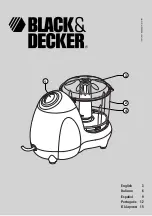
TECHNIQUES FOR
KNEADING YEAST DOUGH
WITH THE DOUGH BLADE
The Premier Series 9-Cup Food Proces-
sor is designed to mix and knead dough
in a fraction of the time it takes to do it
by hand. You will get perfect results every
time if you follow these directions.
NEVER TRY TO PROCESS DOUGH
THAT IS TOO STIFF TO KNEAD
COMFORTABLY BY HAND.
There are two general types of yeast
dough. Typical bread dough is made with a
fl our mix that contains at least 50% white
fl our. It is uniformly soft, pliable and slightly
sticky when properly kneaded.
It always cleans the inside of the work
bowl completely when properly kneaded.
Typical sweet dough contains a higher pro-
portion of sugar, butter and/or eggs than
typical bread dough. It is rich and sticky
and it does not clean the inside of the work
bowl.
It requires less kneading after the ingredi-
ents are mixed. Although 30 seconds are
usually suffi cient, 60 to 90 seconds give
better results if the machine does not slow
down. Except for kneading, the processing
procedures are the same for both types of
dough.
Machine capacity
Recommended maximum amount of fl our
is 4 cups of all-purpose fl our or 2½ cups
of whole-grain fl our. If a bread dough calls
for more than the recommended amounts
of fl our, mix and knead it in equal batches.
Do the same for sweet doughs that call for
more than 3½ cups of fl our.
Using the right blade
Use the dough blade when the recipe calls
for more than 3½ cups (17½ ounces/875
ml) of fl our. Use the metal chopping blade
when a recipe calls for less than 3½ (875
ml) cups of fl our.
Because the dough blade does not extend
to the outside rim of the work bowl, it
cannot pick up all the fl our when small
amounts are processed.
Measuring the fl our
It’s best to weigh it. If you don’t have
a scale, or the recipe does not specify
weight, measure by the stir, scoop and
sweep method. Use a standard, graduated
dry measure, not a liquid measuring cup.
With a spoon or fork, stir the fl our in its
container. Do not measure fl our directly
out of the bag; it is too packed to get an
accurate measure. With the dry measure,
scoop up the fl our so it overfl ows. With a
spatula or knife, sweep excess fl our back
into the container so the top of the mea-
sure is level.
Do not pack fl our into the dry measure.
Proofi ng the yeast
The expiration date is marked on the
package. To be sure your yeast is active,
dissolve it in a small amount of warm liquid
(about 1/3 cup [75 ml] for one package of
dry yeast). The temperature of liquid used
to dissolve and activate yeast must be
between 105° and 115°F (40° and 46°C).
Yeast cells are not activated at tempera-
tures lower than this and they die when
exposed to temperatures higher than
130°F (54°C).
If the recipe includes a sweetener like
sugar or honey, add a teaspoon with the
yeast. If no sweetener is called for, add a
pinch, or add a pinch of fl our. The yeast
won’t foam without it. Let the mixture
stand until it foams, up to 10 minutes. If it
does not foam, discard and begin again
with fresh yeast.
Processing dry ingredients
Put the fl our in the work bowl with all the
other dry ingredients. If the recipe calls for
herbs, oil or solid fats like butter, add them
with the fl our. Turn the machine on and let
it run for about 20 seconds. (Cheese, nuts
and raisins may be added with the dry
ingredients or during the fi nal kneading.
To leave them almost whole, add them 5
seconds before you stop kneading. For a
fi ner texture, add them sooner.)
Adding liquids
All liquid should be added through the small
feed tube while the machine is running. Add
liquid in a slow, steady stream, only as fast
as dry ingredients absorb it. If liquid sloshes
15
Содержание DLC-2
Страница 70: ...70 Notes...
Страница 71: ...71...
















































